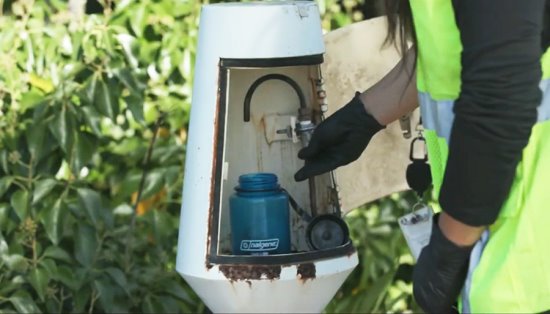| | Published November 24th, 2021
| What's in your water?
| | | By Vera Kochan |  | | An EBMUD technician performs a quality check Photo provided |
What's in your water? Hopefully nothing, but just to put the public's mind at ease, East Bay Municipal Utility District representatives held an Oct. 20 Zoom presentation to enlighten customers within their jurisdiction.
 EBMUD Public Affairs Representative Sharla Sullivan, Manager of Public Quality Susan Teefy, Water Distribution Supervisor Javier Ramos, and California Water Board Division of Drinking Water North Coast Sectional Chief Stefan Cajina were all on hand during the informative session to explain and answer any questions.
EBMUD Public Affairs Representative Sharla Sullivan, Manager of Public Quality Susan Teefy, Water Distribution Supervisor Javier Ramos, and California Water Board Division of Drinking Water North Coast Sectional Chief Stefan Cajina were all on hand during the informative session to explain and answer any questions.
 There are six water treatment plants under EBMUD's umbrella with the largest located in Orinda. The facility was completed in 1936, and is considered the heart of the system. Far-sighted engineers created the plant in a way that uses gravity to keep the water flowing, thereby cutting down on the need for electricity. The original filter beds, which help to screen out finer particles in the water have been upgraded, but for the most part continue to be operational in the first step to water safety. The water goes through several main processes on its way to your faucet: coagulation, filtration and disinfection.
There are six water treatment plants under EBMUD's umbrella with the largest located in Orinda. The facility was completed in 1936, and is considered the heart of the system. Far-sighted engineers created the plant in a way that uses gravity to keep the water flowing, thereby cutting down on the need for electricity. The original filter beds, which help to screen out finer particles in the water have been upgraded, but for the most part continue to be operational in the first step to water safety. The water goes through several main processes on its way to your faucet: coagulation, filtration and disinfection.
 Before the water even shows up in Orinda it takes a long journey from the Sierra Mountains and the Mokelumne River via aqueducts. "From the control center, EBMUD mixes coagulants into the raw water to force very small particles to clump together," stated Teefy. "We also add a type of chlorine to kill pathogens." During the filtration process the water moves through two concrete channels into filter beds made of anthracite and sand to trap and remove the coagulated particles. Next ammonia and fluoride (a state requirement) is added to further disinfect and promote dental health along with sodium hydroxide to prevent corrosion in the distribution pipes that carry the water.
Before the water even shows up in Orinda it takes a long journey from the Sierra Mountains and the Mokelumne River via aqueducts. "From the control center, EBMUD mixes coagulants into the raw water to force very small particles to clump together," stated Teefy. "We also add a type of chlorine to kill pathogens." During the filtration process the water moves through two concrete channels into filter beds made of anthracite and sand to trap and remove the coagulated particles. Next ammonia and fluoride (a state requirement) is added to further disinfect and promote dental health along with sodium hydroxide to prevent corrosion in the distribution pipes that carry the water.
 According to Teefy, EBMUD conducts 20,000 tests annually in every step of the treatment process to ensure that the drinking water is of the highest quality before it arrives to 800,000 customers. These tests check for a variety of contaminants that fall under three categories: physical, chemical, and biological. Physical contaminants may include sticks, dirt, sand and dissolved solids. Chemical contaminants may contain run-off from manufacturing, agriculture and other human-made contaminants. Some are already present in nature such as arsenic. Biological contaminants include bacteria, viruses and other microbes.
According to Teefy, EBMUD conducts 20,000 tests annually in every step of the treatment process to ensure that the drinking water is of the highest quality before it arrives to 800,000 customers. These tests check for a variety of contaminants that fall under three categories: physical, chemical, and biological. Physical contaminants may include sticks, dirt, sand and dissolved solids. Chemical contaminants may contain run-off from manufacturing, agriculture and other human-made contaminants. Some are already present in nature such as arsenic. Biological contaminants include bacteria, viruses and other microbes.
 There are regulators on both the state and federal level that monitor the public's drinking water. The California State Water Resources Control Board and the United States Environmental Protection Agency put EBMUD through a series of checks and balances, stated Cajina. Permitting, inspections/enforcement, review of water system operations, review of contaminants monitoring, certification of environmental laboratories that analyze drinking water samples, and responding to drinking water emergencies such as wildfires, earthquakes and droughts are all part of water safety measures.
There are regulators on both the state and federal level that monitor the public's drinking water. The California State Water Resources Control Board and the United States Environmental Protection Agency put EBMUD through a series of checks and balances, stated Cajina. Permitting, inspections/enforcement, review of water system operations, review of contaminants monitoring, certification of environmental laboratories that analyze drinking water samples, and responding to drinking water emergencies such as wildfires, earthquakes and droughts are all part of water safety measures.
 "What's not in your water are PFAS (Perfluoroalkyl Substances), lead or pathogens," said Teefy. "PFAS are human-made contaminants, and the source where our water comes from has protected watersheds that don't have factories, airports or landfills that can leak PFAS into the environment." Lead has been removed from all service lines decades ago, and any pathogens (diseases) have been removed due to rigorous treatments done by EBMUD. If you'd like to test for lead in the pipes on your property (these are not under the EBMUD jurisdiction) you may request a free home lead test kit by visiting: www.ebmud.com/lead. For additional questions about water quality call: State Water Board North Coast (707) 576-2220 or EBMUD 1-866-403-2683.
"What's not in your water are PFAS (Perfluoroalkyl Substances), lead or pathogens," said Teefy. "PFAS are human-made contaminants, and the source where our water comes from has protected watersheds that don't have factories, airports or landfills that can leak PFAS into the environment." Lead has been removed from all service lines decades ago, and any pathogens (diseases) have been removed due to rigorous treatments done by EBMUD. If you'd like to test for lead in the pipes on your property (these are not under the EBMUD jurisdiction) you may request a free home lead test kit by visiting: www.ebmud.com/lead. For additional questions about water quality call: State Water Board North Coast (707) 576-2220 or EBMUD 1-866-403-2683. |
| | | | | | | | | | | | |




